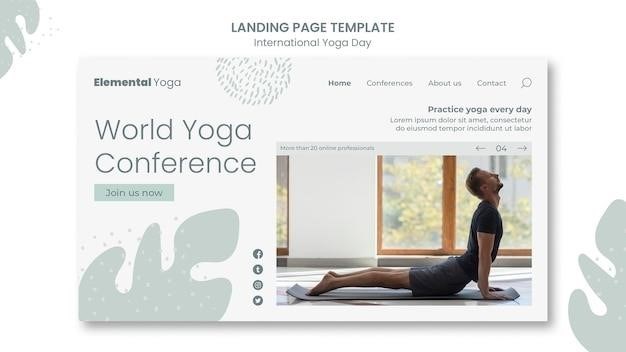What is Somatic Yoga?
Somatic yoga uniquely blends traditional yoga poses with a profound focus on internal body sensations. It cultivates deep body awareness, flexibility, and relaxation through mindful movement, promoting a strong mind-body connection and overall well-being. This gentle approach helps release tension and stress, fostering inner peace.
Benefits of Somatic Yoga
Somatic yoga offers a multitude of benefits extending beyond physical flexibility. By fostering a deep connection between mind and body, it cultivates stress reduction and emotional regulation. The gentle, mindful movements help release tension held within the body, easing anxiety and promoting relaxation. Improved body awareness allows for better posture and movement efficiency, reducing the risk of injuries. Furthermore, somatic yoga aids in pain management by addressing the emotional and mental components often linked to chronic pain. The practice can enhance self-compassion and acceptance, leading to improved mental well-being and a greater sense of self-awareness. It encourages a more conscious and present approach to daily life, enhancing overall quality of life. The calming effects of somatic yoga contribute to better sleep patterns and improved energy levels throughout the day. This holistic approach to well-being makes somatic yoga a valuable tool for personal growth and self-care.
Somatic Yoga and Chronic Pain
Chronic pain, often perceived as purely physical, is increasingly understood to have significant mental and emotional components; Somatic yoga offers a unique approach to pain management by addressing these interconnected aspects. The gentle, mindful movements help release muscular tension and improve flexibility, directly alleviating pain in many cases. More importantly, the practice fosters self-awareness, allowing individuals to recognize the link between emotions, thoughts, and physical sensations. By cultivating a compassionate relationship with the body, somatic yoga helps to reduce the emotional distress often associated with chronic pain. This holistic approach empowers individuals to take an active role in managing their pain, fostering resilience and improving overall quality of life. The focus on breathwork and mindful movement facilitates relaxation, reducing stress and promoting the release of endorphins, the body’s natural pain relievers. This combination of physical and emotional support makes somatic yoga a valuable tool for those living with chronic pain.

Somatic Yoga Exercises⁚ A Beginner’s Guide
This section provides a gentle introduction to somatic yoga, perfect for beginners. Explore simple, accessible poses designed to cultivate body awareness and promote relaxation. These exercises are ideal for stress reduction and improving overall well-being.
Gentle Poses for Stress Relief
Beginners can find immense stress relief through simple somatic yoga poses. The Child’s Pose, a deeply restorative posture, gently stretches the hips, thighs, and ankles while calming the nervous system. Focus on the breath, allowing each inhale to deepen and each exhale to release tension. The Cat-Cow pose, a flowing movement between spinal flexion and extension, gently mobilizes the spine and promotes relaxation. Feel the natural rhythm of your breath coordinating with each movement. Seated Forward Fold, with a focus on lengthening the spine and releasing tension in the shoulders and neck, provides a gentle stretch that calms the mind. Remember, the goal is not to force the stretch but to gently ease into it, allowing the body to release tension at its own pace. These poses, when practiced mindfully, offer a path to stress reduction and enhanced well-being, making them ideal for beginners and experienced practitioners alike. Pay close attention to your body’s cues, modifying poses as needed to maintain comfort and prevent strain.
Exercises for Improved Flexibility and Mobility
Somatic yoga offers a unique approach to enhancing flexibility and mobility, focusing on mindful movement and body awareness rather than forceful stretching. The gentle, sustained stretches in poses like the Warrior II, with its emphasis on lengthening the legs and opening the hips, improve range of motion over time. The Tree Pose, requiring balance and controlled movement, strengthens stabilizing muscles while gently increasing hip and ankle flexibility. Mindful movements, such as the slow, controlled transitions between poses, are crucial for improving mobility. These movements help to increase awareness of the body’s limitations and encourage gradual, safe expansion of range of motion. The focus on internal sensations guides the practitioner to honor their body’s limits and gently work toward improved flexibility, fostering a deeper connection between mind and body. Remember to breathe deeply throughout each pose and movement, allowing the breath to guide and support the process of increasing flexibility and mobility.
Advanced Somatic Yoga Techniques
Advanced somatic yoga delves deeper into the mind-body connection, exploring techniques like working with stored emotions and refining the breathwork to enhance the meditative aspects of the practice for a more profound experience.
Working with Stored Emotions
Advanced somatic yoga techniques often incorporate methods for addressing emotional trauma and stored tension within the body. These techniques help to identify and release trapped emotions that may manifest as physical pain or discomfort. The process involves mindful movement and breathwork to access and process these emotions in a safe and supportive environment; By cultivating self-awareness and compassion, practitioners can develop healthier coping mechanisms and emotional resilience. This can lead to a significant reduction in stress and anxiety, allowing for a greater sense of emotional freedom and improved mental clarity. The hips, in particular, are often highlighted as areas where emotions tend to be stored, and targeted exercises can facilitate their release. Specific poses and movements are used to gently stimulate these areas, releasing pent-up energy and facilitating the processing of stored emotions. The goal is not to suppress or ignore these feelings, but rather to acknowledge them, understand their origins, and ultimately integrate them into a more holistic sense of self. This approach recognizes the interconnectedness of physical and emotional well-being, promoting a more balanced and harmonious state. Through consistent practice, individuals can cultivate a greater capacity for emotional regulation and self-compassion.
Deepening the Mind-Body Connection
Advanced somatic yoga emphasizes cultivating a profound connection between the mind and body. This involves heightened awareness of internal sensations, subtle movements, and the interplay between physical and emotional states. Practitioners learn to observe their bodies with curiosity and compassion, noticing tension, relaxation, and energy flow. This heightened awareness allows for a more nuanced understanding of how thoughts, emotions, and experiences manifest physically. Through mindful movement and breathwork, the practitioner cultivates a deeper sense of embodiment and self-acceptance. The practice encourages a non-judgmental observation of internal experiences, fostering self-compassion and a more positive relationship with the body. This enhanced mind-body connection can translate to improved emotional regulation, stress reduction, and a greater sense of overall well-being. It provides a pathway to understand the body’s wisdom and intuitive responses, fostering self-trust and confidence. By attuning to the body’s subtle cues, individuals gain a more profound understanding of their own needs and boundaries. This improved self-awareness promotes a more balanced and harmonious integration of mind and body, leading to greater overall well-being and resilience.

Finding Somatic Yoga PDFs
Numerous online resources offer downloadable somatic yoga exercise PDFs. These resources often provide guided sequences for beginners and advanced practitioners, catering to various needs and experience levels. Explore reputable websites and online yoga communities.
Resources for Downloadable Exercises
Locating high-quality somatic yoga exercise PDFs requires careful consideration of the source’s credibility. Reputable yoga studios or certified instructors often provide downloadable materials on their websites, ensuring accuracy and safety. Look for PDFs that detail proper form and modifications for various fitness levels. Online platforms specializing in fitness and wellness resources may also offer downloadable somatic yoga guides, but always check reviews and credentials before downloading. Many free resources exist, but paid options may provide more comprehensive content and personalized instruction. Remember to prioritize safety; if a pose feels uncomfortable, stop immediately and consult a healthcare professional or experienced yoga teacher. The internet offers a vast array of options, but careful selection ensures a safe and effective practice.